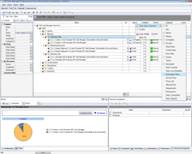 |
|
 |
VIP Task Manager |
 |
|
 |
VIP Task Manager |
|
Necessity of WBS A key method of effective project planning is to divide the project into manageable parts that can be individually estimated, planned and controlled. The work breakdown structure is an efficient strategy that represents the project's statement of work and tasks making it easier for project participants to communicate and understand each other. Let's imagine that we have defined outcomes which should be reached on completion of a project, and have coordinated them with all interested persons. However we cannot plan the project being guided only by the list of these outcomes. To plan the project it is necessary to define what specific works and tasks should be executed for achievement of these outcomes, i.e. for successful accomplishment of the project. For this purpose is applied. WBS is a key element of the project planning. Without that it is impossible to define work which is necessary for project performance. So it is impossible to define either project cost or its planned schedule. And also it is impossible to calculate what resources are required for performance of the project and during what time these resources should be available. The purposes set to the project, will be achieved in time only in case of careful elaboration of the detailed, stage-by-stage budget of the project. At last, without having a concept about what tasks should be executed during the project, it is impossible to operate risks. For the decision of all listed above problems, WBS is required. |
||
|
WBS creation It is reasonable to consider WBS is finished when elementary individual tasks are defined. Responsibility for each elementary work (task) should be charged to one and the same participant of the project. It is very important to understand that the primary goal of WBS is to break down the project into some sub-projects up to that moment when there will be a possibility to assign elementary tasks. At the lower level of WBS there should be a description of elementary tasks which can be executed by a responsible person. |
||
|
If this person is going to perform task (but not to manage it), this level can be recognized as the lowermost level of WBS. This level is called as level of the task or specific actions. It is extremely important that at each lowermost level of WBS there should be only one employee assigned, and only he is responsible for work package or elementary task. If the project is big, WBS can have rather general character. You can stop the breakdown at the lowermost level which is tracked by the project head. This level is called work package. On this level of WBS there are separate deliverable items for the costs tracking and performance measuring. For example, we have a project for development of a software system. A component of that system is a single program developed by several programmers. Typically the project head will calculate and track the cost of the entire component. Usually he is not interested in estimating the cost of writing sub-components of this item such as individual subroutines. Hence, the base level of work breakdown structure is defined by the level where you can exactly calculate costs and efficiently control project development. |
||
|
WBS by VIP Task Manager The software at which you can apply potential of WBS and get benefits of efficient project planning is VIP Task Manager. This software is designed for project planning and development. In Task Tree View you can create project structure using task groups and tasks. A task group can have a set of sub-groups and the lower level is particular tasks. Using custom fields you are capable to specify a set of details for each task groups like costs per work package, estimated time for a sub-project to be completed, set individual plans, etc. Custom fields project head with flexible mechanism of mathematical calculations and logic expressions. When creating a custom field, you can specify math expression in "Formula" parameter and define logic dependence using conditions. |
||
|
VIP Task Manager has a system of reporting that allows to build reports in graph or text view and export reports to Microsoft Excel application. Also in VIP Task Manager you can send task with all task details by email in several clicks which allows to send "quick" report to project head. Read also a new article about process management - project management client-server software for Windows |
||
 |
|
 |
VIP Task Manager |




 Play Demo
Play Demo
 Play Demo
Play Demo